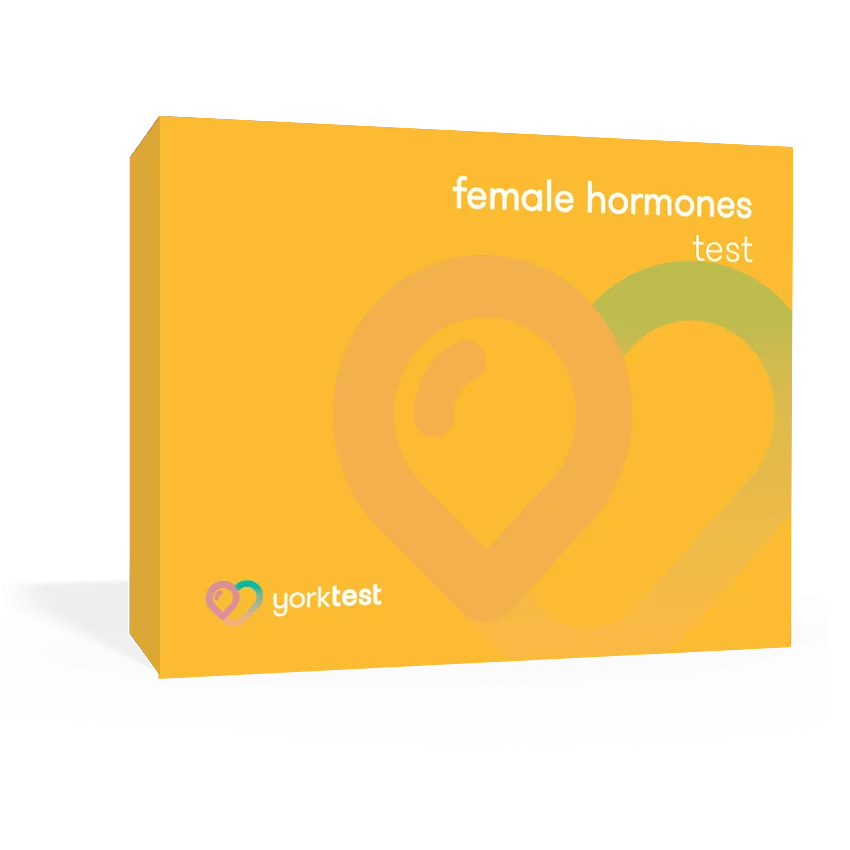Female Hormones Test
£79.00 Original price was: £79.00.£55.00Current price is: £55.00.
+ FREE Delivery on all orders
Do you have irregular periods or are you wondering about your fertility? Are you concerned about your general wellbeing, energy levels, weight or mood?
Female hormone levels vary throughout the menstrual cycle, but imbalances can impact your everyday health in lots of different ways.
- Provides results for 6 key female hormone markers, including LH and FSH
- Simple at-home finger-prick blood test. No social interaction required
- Provides hospital standard, easy-to-read results
- Provides clear information and signposting to see your GP if required
- Suitable for women aged 20 years and older; although for information about your menopause status you may prefer to take our Menopause Test
- Not suitable for those taking hormonal contraception or hormone replacement therapy
- Sample taken on Day 3 of your menstrual cycle (if cycling)
- Only available in the UK
Optimise Your Health At Home.
Take control of your health in a positive way. Understand whether your female hormones status may be impacting your health and what you can do to help yourself.
Using a quick and easy home-to-laboratory finger-prick blood test. Get your results within 7 days.
Be aware that finding out your female hormone levels is the first step to making positive changes. It is also easy to track your hormone levels over time to see how they are changing with age.
TAKE STEPS TO CHANGE YOUR LIFE FOR THE BETTER.
Measuring your female hormone status is important, particularly if you……
- want to know more about what might be impacting your health
- experience irregular periods
- are concerned about your fertility
- suffer from low energy
- suffer from acne
- suffer from mood swings
- wonder if you are going through early menopause
- are intrigued to find out more
What's In The Test?

HOME TO LABORATORY KIT
What’s In The Female Hormones Test
Your kit includes a free return envelope included, making it easy for you to post your sample back to the laboratory. Your test results will then be available via our secure online Wellness Hub.
- Female Hormones Test
- A prepaid return envelope (UK only)
- Two single-use lancets
- One blood collection tube
- One plastic blood collection tube case
- Two adhesive plasters
- A cleansing wipe
What We Test For
- LH and FSH are hormones produced by the pituitary gland in the brain. These hormones are responsible for ensuring the normal function of the ovaries and the menstrual cycle.
- Prolactin is a hormone that is produced by the pituitary gland in the brain and plays a role in reproductive health.
- Testosterone is the main male sex hormone, but levels are also important in women.
- Sex-hormone Binding Globulin (SHBG) is a key protein that binds sex hormones as they circulate in the blood. The SHBG level provides important information to help calculate the levels of hormones that are biologically active and available for use.
- Sex-hormone Binding Globulin (SHBG) is a key protein that binds sex hormones as they circulate in the blood. The SHBG level provides important information to help calculate the levels of hormones that are biologically active and available for use.
Female Hormones Test FAQ's
Hormones are found in saliva, urine, and blood. While all of these specimen samples can be used to test female hormone levels, blood testing is the most sensitive and accurate method.
It’s important to note that not all female hormone tests are treated equally. Some blood test panels are tailored specifically for fertility and evaluating the reproductive abilities of women, while others are focused on Menopause, puberty, and other specific conditions. The best way to test female hormones is a blood test that covers specific markers of interest, such as Luteinizing Hormone (LH), Follicle Stimulating Hormone (FSH), Prolactin, Testosterone and Sex-hormone Binding Globulin (SHBG), which all play a role in a woman’s reproductive health.
Because blood is the most accurate way to determine female hormone levels, most testing is done by way of a finger-prick test or blood draw. The benefit of a finger-prick method is that testing can be carried out at home and mailed to an accredited laboratory. Typically, a blood draw is conducted in a clinical setting, such as a physician’s office, and later sent to a lab for testing. While both methods are accurate and effective, many women find it easier and more affordable to use at-home finger-prick tests to determine their hormone levels. Keep in mind that the timing of when a blood sample is taken matters considerably to achieve accurate test results.
When it comes to testing hormones in women, the timing of the test is very important. For females that are having periods, it’s generally best to test hormone levels on day 3 of their menstrual cycle, assuming a typical 28-day cycle. (Day one begins at the start of the menstrual period.)
For women who experience longer cycles (e.g. 40-day cycles), it’s also advised to conduct the test on day 3.This is because it’s generally recommended to assess certain health and hormonal markers during a woman’s early follicular phase, which is characterised by low progesterone and low levels of LH and FSH. This means that any tendency towards menopause or low ovarian reserve will be picked up.
In situations in which a woman is not menstruating, a female hormone blood test can be done at any time.
Follicle-stimulating hormone, or FSH, is a hormone released by the pituitary gland and acts on the ovaries to stimulate the growth of ovarian follicles which contain a female’s eggs. FSH also activates the granulosa cells that surround ovarian follicles to trigger the production of oestrogen, an essential hormone for regulating the menstrual cycle in women.
FSH is one of the two primary types of gonadotropic hormones, or gonadotropins, which are key female hormones released from the pituitary gland in the brain and into the bloodstream, and then go on to act on the ovaries. In addition to FSH, the other type of gonadotropin is luteinizing hormone (LH).
Cells in the hypothalamus can sense when gonadotropin levels fall toward the end of a woman’s menstrual cycle, which stimulates the pituitary gland to produce and release more FSH and LH into the bloodstream. The increase in FSH stimulates the growth of the follicle in the ovary.
Although FSH levels will vary widely depending on a woman’s age, stage of life, and menstrual period, FSH levels typically need to be at an optimum level depending on the stage of the cycle for a woman to conceive. When FSH levels are either too low or too high, it can be much more difficult to get pregnant because FSH has such a profound effect on a woman’s menstrual cycle and whether or not she ovulates.
One way to confirm menopause in women is to test for elevated FSH levels. When FSH blood levels are consistently high, and a menstrual period has not occurred for a year, it can indicate menopause has been reached. While FSH levels can be a helpful marker in confirming menopause, elevated levels alone and can sometimes be misleading, especially if certain hormone therapies, like birth control pills, are being used.
Perimenopause, or the transition period before menopause, can last for several years in some women. Generally, FSH levels are higher than normal but during this stage, FSH levels are also known to fluctuate. Because of this variation of FSH, testing for FSH alone can be misleading in determining perimenopause. Instead, a more comprehensive assessment of markers, including LH and oestrogen are needed for a menopause test.
It is possible to lower FSH levels with oestrogen medication and birth control pills. Lifestyle changes like reducing stress, losing weight, diet, exercise, herbal supplements, and acupuncture have also supposedly been reported to help lower FSH levels.It’s critical to note that reducing high FSH levels will not directly influence a woman’s ovarian reserve or her chances of getting pregnant. In other words, the primary issue is egg quality, and simply lowering FSH levels will not work in improving egg quality and fertility.
Next to FSH, Luteinizing Hormone (LH) is the other primary gonadotropin hormone that stimulates ovulation in females. As a vital biochemical in regulating one’s reproductive system, elevated LH levels in women are what trigger hormone production needed for pregnancy. It’s common to have LH levels checked as part of fertility or menstrual-related blood test.
LH is an important chemical that effectively controls the menstrual cycle in women. It’s secreted from the pituitary gland into the bloodstream and signals to the sex organs to produce key hormones (progesterone or testosterone) which support reproductive health in both men and women. For females, LH levels rise dramatically just before ovulation to trigger the release of an egg from the ovary. This makes LH a key player in stimulating the female reproductive system and supporting a healthy pregnancy.
Testing your LH levels is the best way to determine whether your numbers fall into a healthy range. Normal LH levels in women depend on a few key factors, such as your age and the stage of the menstrual cycle you’re in. Because LH levels peaks at the middle phase of your cycle, the timing of your hormone test matters. For younger women who have yet to experience menopause, normal LH levels will stay low at day 3 of the cycle. After menopause, normal LH levels will be consistently higher (Source).
Low LH levels may indicate that your pituitary gland is not producing adequate hormones required to stimulate necessary changes to support reproductive health. This is a condition referred to as hypopituitarism. Other conditions that contribute to lower than normal LH levels are Kallmann syndrome (a rare condition) and Functional Hypothalamic Amenorrhea (a condition in women characterised by irregular or missed periods due to excessive exercise).
LH levels shift dramatically across a woman’s menstrual cycle to prime the body for ovulation. Also known as an “LH surge,” the day before ovulation is a period in which LH levels increase, which is generally considered the optimal window for conception.
It’s important to note that what’s considered a normal LH level for pregnancy varies widely. One major Study showed that the average LH on the day before ovulation was about 44.6 IU/L3. Other Sources define an ovulation-indicated LH range of 12.2 to 118 IU/L. While every woman may experience different LH surge patterns, Studies Suggest upwards of a 42%-48% increase in LH in the initial stage before ovulation. These levels will of course depend on the reference ranges too used by the specific laboratory carrying out the LH test.
Sex hormone-binding globulin (SHBG) is an essential protein that’s primarily synthesized in the liver but also produced in smaller quantities by the placenta, uterus, breast, ovaries, and brain. SHBG serves a vital role in binding to sex hormones, and transporting these hormones around the body. Abnormal levels of SHBG are associated with a number of different diseases, with high levels being found in conditions like hyperthyroidism, hypogonadism, and androgen insensitivity5.
The primary function of SHBG is to control the amount of testosterone and oestradiol available in the body. The production of SHBG ultimately influences the balance between these two hormones, which shapes overall reproductive health in both men and women. Only hormones that are unbound (non-binding to SHBG) can be used by the body. When SHBG binds to testosterone and oestradiol, these hormones become inactive. In short, the higher the SHBG concentration, the fewer sex hormones are available to the body, while lower SHBG levels generally mean more sex hormones are available.
In addition to fertility problems surrounding conception and menstrual cycles, the symptoms of high SHBG in women can also include:
- Decreased sex drive
- Vaginal dryness
- Memory loss
- Low mood and fatigue
- Reduced wellbeing
Having an SHBG blood test done, or a female hormone test that includes SHBG is critical when these symptoms start showing up.
Androgens, both in states of depletion and excess, have been implicated in reproductive health disorders among women8. Free Androgen Index or FAI is a ratio that can be used to determine abnormal androgen levels. The FAI ratio is calculated by dividing the total testosterone level by the SHBG level and then multiplying that number by 100 for an index measurement.
Roughly half of the testosterone found in the bloodstream is tightly bound to SHBG and the other half is weakly bound to albumin. Only a small percentage is considered unbound or free testosterone (generally less than 0.7% in females). Because only free testosterone is capable of binding to tissue receptors to exert its effects, unbound testosterone is known as the best marker of a woman’s androgen status.
FAI provides insight into a female’s free testosterone level. FAI is a guidance metric that’s factored alongside other markers like FSH and LH, to name a few.
In healthy women, the ovaries and adrenal glands produce about 40% to 50% of the body’s testosterone. Ovarian overproduction of androgens, thereby resulting in high FAI values, is a condition of the ovaries producing too much testosterone. Symptomatically, this can lead to the development of male characteristics in a female, including concerns surrounding reproductive health.
Polycystic ovary syndrome (PCOS) as well as tumors of the ovaries can result in overproduction of androgen. Additionally, Cushing’s Disease, a condition of the pituitary gland that involves excess production of corticosteroids, can also cause symptoms of masculine body changes in women. While rare, tumors in the adrenal glands can also lead to overproduction of androgens, elevated FAI values, and fertility issues in women.
Biochemical hyperandrogenism in PCOS is characterised by elevated serum testosterone concentrations and increased FAI values. Similarly, heightened FAI values overlap with other conditions, including depression, hirsutism, and menstrual irregularities, which are commonly associated with PCOS. Studies Have Found that there is a significant difference in FAI between patients with PCOS and healthy individuals10. In other words, FAI can help provide a diagnostic value for women with PCOS, thereby enabling a better outlook on treatment options and supporting health-related quality of life.
Biochemical hyperandrogenism in PCOS is characterised by elevated serum testosterone concentrations and increased FAI values. Similarly, heightened FAI values overlap with other conditions, including depression, hirsutism, and menstrual irregularities, which are commonly associated with PCOS. Studies Have Found that there is a significant difference in FAI between patients with PCOS and healthy individuals10. In other words, FAI can help provide a diagnostic value for women with PCOS, thereby enabling a better outlook on treatment options and supporting health-related quality of life.
References
1 Meczekalski B, Katulski K, Czyzyk A, Podfigurna-Stopa A, Maciejewska-Jeske M. Functional hypothalamic amenorrhea and its influence on women’s health. J Endocrinol Invest. 2014;37(11):1049-1056. doi:10.1007/s40618-014-0169-3
2 D’Aniello, G et al. “Reproductive implication of D-aspartic acid in human pre-ovulatory follicular fluid.” Human reproduction (Oxford, England) vol. 22,12 (2007): 3178-83. doi:10.1093/humrep/dem328
3 Johnson, Sarah & Weddell, Sarah & Godbert, Sonya & Freundl, Guenter & Roos, Judith & Gnoth, Christian. (2015). Development of the first urinary reproductive hormone ranges referenced to independently determined ovulation day. Clinical Chemistry and Laboratory Medicine. 10.1515/cclm-2014-1087.
4 Park, Susanna J et al. “Characteristics of the urinary luteinizing hormone surge in young ovulatory women.” Fertility and sterility vol. 88,3 (2007): 684-90. doi:10.1016/j.fertnstert.2007.01.045
5 Selby, C. “Sex hormone binding globulin: origin, function and clinical significance.” Annals of clinical biochemistry vol. 27 ( Pt 6) (1990): 532-41. doi:10.1177/000456329002700603
6 Saez-Lopez, Cristina et al. “Resveratrol Increases Hepatic SHBG Expression through Human Constitutive Androstane Receptor: a new Contribution to the French Paradox.” Scientific reports vol. 7,1 12284. 25 Sep. 2017, doi:10.1038/s41598-017-12509-x
7 Goldin, B R et al. “The effect of dietary fat and fiber on serum estrogen concentrations in premenopausal women under controlled dietary conditions.” Cancer vol. 74,3 Suppl (1994): 1125-31. doi:10.1002/1097-0142(19940801)74:3+<1125::aid-cncr2820741521>3.0.co;2-5
8 Kathryn Korkidakis, Ann, and Robert L Reid. “Testosterone in Women: Measurement and Therapeutic Use.” Journal of obstetrics and gynaecology Canada : JOGC = Journal d’obstetrique et gynecologie du Canada : JOGC vol. 39,3 (2017): 124-130. doi:10.1016/j.jogc.2017.01.006
9 Keevil, Brian G et al. “The free androgen index is inaccurate in women when the SHBG concentration is low.” Clinical endocrinology vol. 88,5 (2018): 706-710. doi:10.1111/cen.13561
10 Wang, Lilin, and Juan Li. “The value of serum-free androgen index in the diagnosis of polycystic ovary syndrome: A systematic review and meta-analysis.” The journal of obstetrics and gynaecology research vol. 47,4 (2021): 1221-1231. doi:10.1111/jog.14681
Related Products
-
£279.00Original price was: £279.00.£195.00Current price is: £195.00. -
£179.00Original price was: £179.00.£125.00Current price is: £125.00. -
£199.00Original price was: £199.00.£139.00Current price is: £139.00. -
£199.00Original price was: £199.00.£139.00Current price is: £139.00.
Payment methods










Reviews
There are no reviews yet.